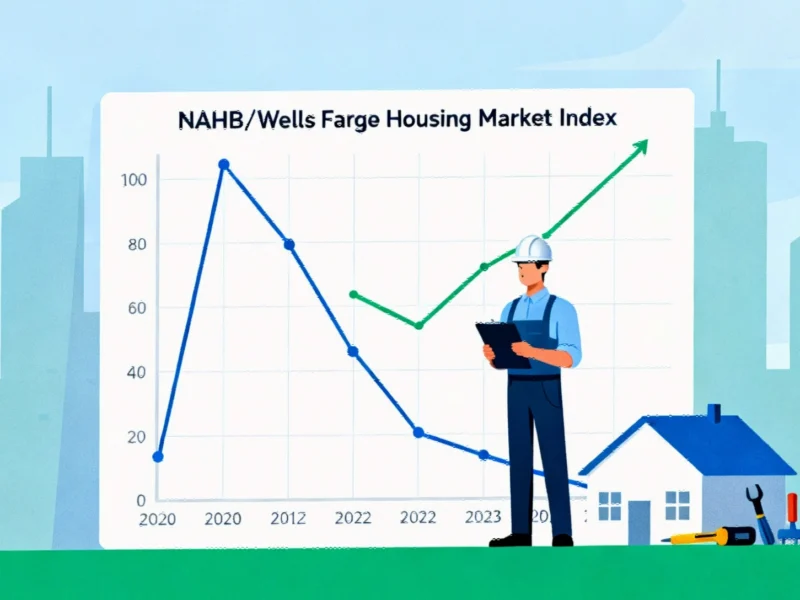Economic Indicator Rises Amid Government Data Gap
The National Association of Home Builders (NAHB)/Wells Fargo Housing Market Index jumped five points in October to 37, reaching its highest level since April and marking the most significant monthly improvement since January 2024. This crucial survey of single-family builders measures confidence in current and expected sales conditions on a 0-100 scale, where readings above 50 indicate more builders view conditions as good rather than poor. The timing is particularly significant given the government statistics pause that has left analysts relying on alternative data sources to gauge housing market activity.
With the Census Bureau expected to delay its official housing construction report, NAHB officials emphasize their index can serve as a reliable proxy for single-family permit trends. Robert Dietz, chief economist at NAHB, noted that historical modeling suggests the October sentiment increase corresponds to approximately a 3% rise in September permits. This development comes as broader economic indicators continue to show mixed signals across various sectors.
Historical Context and Recent Volatility
The builder sentiment survey, created in 1985, asks participants to rate current sales, expected sales over the next six months, and traffic of prospective buyers. The index reached an unprecedented high of 90 in late 2020 when mortgage rates hovered near historic lows, then plummeted dramatically as rates climbed throughout 2022. The decline was particularly sharp – from 83 in January 2022 to 31 in December when the Federal Reserve raised interest rates by half a percentage point to their highest level in 15 years.
More recently, sentiment bottomed out at 32 in both August and September of this year, matching the lowest level since December 2022. This context makes October’s rebound particularly noteworthy and suggests a potential turning point for the housing sector. The improvement aligns with broader market movements as investors assess changing economic conditions.
Federal Reserve Policy Shift Drives Improvement
The sentiment rebound coincides directly with the central bank’s reversal of its monetary tightening policy. The Fed cut its benchmark interest rate last month for the first time since December 2024 and has signaled additional reductions could follow. Lower borrowing costs have already begun nudging mortgage rates downward, improving affordability and encouraging cautious optimism among builders.
“The 30-year fixed-rate mortgage fell from just above 6.5% at the start of September to 6.3% in early October,” said Robert Dietz. He added that builders anticipate a “slightly improving sales environment” as rates decline, despite ongoing challenges including labor shortages and construction costs. This monetary policy shift demonstrates how housing often serves as an early indicator of broader economic changes, as mortgage rate fluctuations quickly impact demand for new homes. The trend mirrors developments in other industries adapting to changing economic conditions.
Market Implications and Investment Outlook
The improved builder sentiment provides welcome news for investors in homebuilding stocks, a sector that has been awaiting signs of relief. The SPDR S&P Homebuilders ETF, which manages $1.9 billion in assets, has declined 15% over the past year, underperforming the S&P 500 by approximately 30 percentage points. Homebuilding shares typically move ahead of actual demand, meaning builder optimism could signal stabilization after a difficult period.
This potential turnaround occurs alongside global market developments that suggest shifting economic dynamics across multiple regions and sectors. The housing sector’s sensitivity to interest rates makes it a key barometer for broader economic health.
Persistent Challenges Despite Improvement
Despite the October uptick, builder sentiment remains subdued relative to historical norms. Only one in three builders describes current conditions as favorable, and 38% report cutting prices – indicating buyers remain sensitive to financing costs. The average discount increased to 6% in October, up from 5% in prior months.
Incentives continue to be widespread, with nearly two-thirds of builders offering them to secure deals. This helps explain why new homes have been selling at lower prices than existing properties. The prevalence of discounts and incentives reflects the same competitive pressures affecting other sectors where businesses must adapt to maintain market position.
Future Outlook Hinges on Continued Fed Support
Buddy Hughes, NAHB’s chairman and a North Carolina builder, characterized recent rate declines as “an encouraging sign for affordability” but noted that “most home buyers are still on the sidelines, waiting for mortgage rates to move lower.” This patience could soon be rewarded if the Federal Reserve maintains its easing trajectory.
Lower rates have the potential to bring more buyers back into the market, spurring new construction and supporting housing-related employment. While the October index doesn’t signify a full recovery, it suggests something that has been largely absent for much of the past two years: positive momentum. This emerging trend complements technological advancements across industries that are driving efficiency and innovation in challenging economic environments.
The housing market’s response to changing monetary policy will be crucial to watch in coming months, particularly as government statistical agencies resume normal operations and provide more comprehensive data to complement survey-based indicators like the NAHB index.
Based on reporting by {‘uri’: ‘forbes.com’, ‘dataType’: ‘news’, ‘title’: ‘Forbes’, ‘description’: ‘Forbes is a global media company, focusing on business, investing, technology, entrepreneurship, leadership, and lifestyle.’, ‘location’: {‘type’: ‘place’, ‘geoNamesId’: ‘5099836’, ‘label’: {‘eng’: ‘Jersey City, New Jersey’}, ‘population’: 247597, ‘lat’: 40.72816, ‘long’: -74.07764, ‘country’: {‘type’: ‘country’, ‘geoNamesId’: ‘6252001’, ‘label’: {‘eng’: ‘United States’}, ‘population’: 310232863, ‘lat’: 39.76, ‘long’: -98.5, ‘area’: 9629091, ‘continent’: ‘Noth America’}}, ‘locationValidated’: False, ‘ranking’: {‘importanceRank’: 13995, ‘alexaGlobalRank’: 242, ‘alexaCountryRank’: 114}}. This article aggregates information from publicly available sources. All trademarks and copyrights belong to their respective owners.



